| Memory Lane: The JMCA Archives
Relive the glorious cantorial past by contributing to the JMCA
website with your recordings, memoirs, letters and photographs of
your very own experiences. See them come to life right here our
website. Share your ‘geshichte’ with the entire
world! Send them to us right here in New York City – make the
donation you’ve always wanted to make of those recordings
in the attic or basement. We know there’s a ton of memorabilia
out there so, nu shoin – send it to us and we’ll
all schep naches! Also, don’t forget that the JMCA is a New York State
501 (c) 3 not-for-profit corporation – so when you’re
thinking of making a gift [no matter what the amount] either go
to our secure ‘Support page’ or contact: Cantor Michael Trachtenburg, Treasurer |
||
| MOSHE KOUSSEWITSKY’S PRE-WAR WARSAW PICTURE FOUND!
Photo: Jewish Ministers Cantors Association of America – (JMCA) – Der Chazzonim Farband. Use or copying of Photo by permission only. Courtesy of the United States Holocaust Museum and YIVO Archives. |
||
| Live recording of Kol Nidre sung at the Central Synagogue
in Moscow, USSR 1956 Cantor Barkin, suffering from a heavy cold, nevertheless began to sing the Kol Nidre with such feeling that the choir responded with great emotion. Suddenly the cantor began to cough and his voice began to break - he was unable to continue singing. With no other cantor available, the service might need to be suspended. Then someone recalled, that a Baal Shacharit, who occasionally sang morning services, was in attendance. The patriarch, about 75 years old and with a flowing white beard, was propelled forward. He began to sing the Kol Nidre prayers as they had never been heard before... See details on back cover of Kol Nidre Album. Courtesy of: Dartmouth Jewish Sound Archive
|
||
 Cantor
Moishe Oysher (1907-1958) was one of the great talents of the Yiddish
theater and gained a reputation not only for his acting, but for his voice.
When not on the stage, Cantor
Moishe Oysher (1907-1958) was one of the great talents of the Yiddish
theater and gained a reputation not only for his acting, but for his voice.
When not on the stage,Moishe Oysher, like his father and grandfather,
served as a cantor. His film debut came with The Cantor's Son in 1936.
There are three Yiddish films in which he starred. In one of the most
famous films, Moishe Oysher is the "Vilner Balabesl", the
cantor who leaves his position as the beloved Vilna Cantor in order
to seek fame and fortune as an opera star in Warsaw. He feels uncomfortable
in his new environment and yearns to return home to his wife, child
and community. The New York Herald-Tribune wrote that the film was "An artistic triumph!" Courtesy of: www.YiddishVideo.com |
||
The German occupation of Denmark did not significantly
change the lives of the Goldbergers during its first years. However,
in the late summer of 1943 the situation altered suddenly. Seeking
retaliation for the activities of the Danish resistance, the Germans seized Jeno and a number of other prominent
Jewish citizens. Fortunately, a sympathetic Danish neighbor was able
to prevent his formal arrest. Several weeks later, on October 1, 1943,
plans for the imminent arrest and deportation of Danish Jewry were
leaked to the Danes, who immediately rallied to the rescue of their
Jewish compatriots, ferrying over 7,000 of them to Sweden. The Goldbergers
were among those Jews who were carried to safety. For the remainder
of the war the family lived in Goteborg, Sweden, where Jeno served
as cantor. In June 1945 the Goldbergers returned to Copenhagen, where
Jeno resumed his former position. Photo courtesy of: The United States Holocaust Museum and Mr. Gus Goldberger |
||
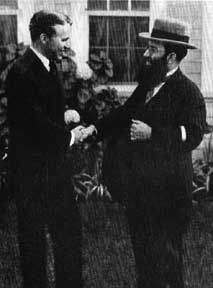 Two
of the greatest stars of their day meet – Charlie Chaplin and Cantor
Josef [Yosele] Rosenblat Two
of the greatest stars of their day meet – Charlie Chaplin and Cantor
Josef [Yosele] Rosenblat |
||
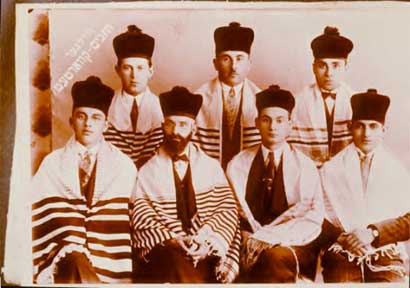 Cantor
Gedalia Ginunski of Beth Medrash Eisiskes and shtetl of Astrin. Member
of the Vilna Hazzanim Quartet - died Auschwitz before 1941 Cantor
Gedalia Ginunski of Beth Medrash Eisiskes and shtetl of Astrin. Member
of the Vilna Hazzanim Quartet - died Auschwitz before 1941Gedalia Ginunski was a cantor in the Beth Medrash
in Eisiskes as well as in the shtetl of Astrin. He was also a member
of the Vilna Hazzanim [Cantors] Quartet. Together with his wife and
children. Gedalia was deported to Auschwitz where he was forced to
perform for the Germans. After an injury to his foot, he was sent
to the gas chambers. His wife and children also perished. Courtesy of: The United States Holocaust Museum Photo Archives |
||
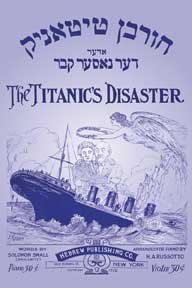 It
is interesting to note that Russotto was an accomplished composer of synagogue
music - especially the much performed "Kol Nidre". Here we have
a 1912 piano arrangement of "Churbon Titanic" by H. A. Russotto. It
is interesting to note that Russotto was an accomplished composer of synagogue
music - especially the much performed "Kol Nidre". Here we have
a 1912 piano arrangement of "Churbon Titanic" by H. A. Russotto. |
||
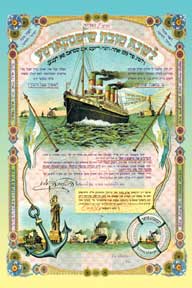 A
ship's Happy New Year Card! L'Shono Tovah! A
ship's Happy New Year Card! L'Shono Tovah! |
||
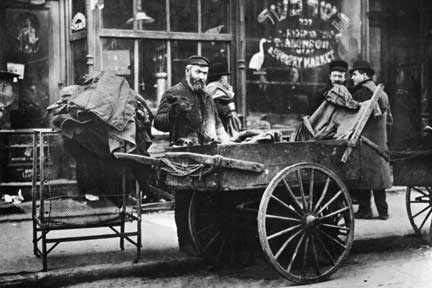 Kosher Meat Market on the lower East Side in the early part of the 20th Century |
Pictures COURTESY OF WWW.BUYENLARGE.COM
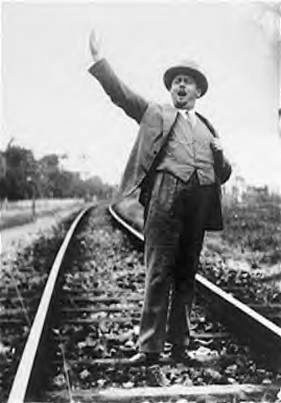
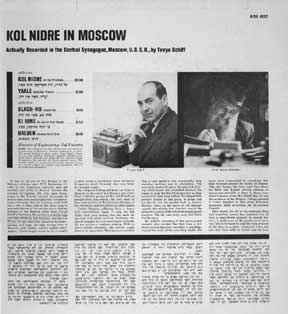
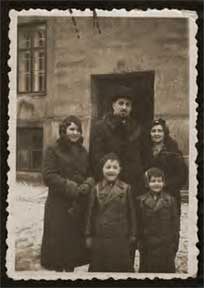 Portrait
of Helen (Berkovic) Goldberger, Eugene Goldberger and their sons
Milan and Leo taken shortly before the family moved to Denmark.
Portrait
of Helen (Berkovic) Goldberger, Eugene Goldberger and their sons
Milan and Leo taken shortly before the family moved to Denmark.